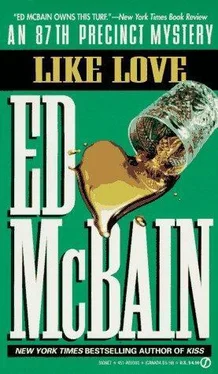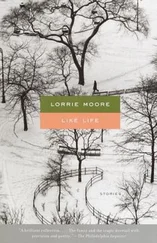Ed McBain - Like Love
Здесь есть возможность читать онлайн «Ed McBain - Like Love» весь текст электронной книги совершенно бесплатно (целиком полную версию без сокращений). В некоторых случаях можно слушать аудио, скачать через торрент в формате fb2 и присутствует краткое содержание. Жанр: Полицейский детектив, на английском языке. Описание произведения, (предисловие) а так же отзывы посетителей доступны на портале библиотеки ЛибКат.
- Название:Like Love
- Автор:
- Жанр:
- Год:неизвестен
- ISBN:нет данных
- Рейтинг книги:4 / 5. Голосов: 1
-
Избранное:Добавить в избранное
- Отзывы:
-
Ваша оценка:
- 80
- 1
- 2
- 3
- 4
- 5
Like Love: краткое содержание, описание и аннотация
Предлагаем к чтению аннотацию, описание, краткое содержание или предисловие (зависит от того, что написал сам автор книги «Like Love»). Если вы не нашли необходимую информацию о книге — напишите в комментариях, мы постараемся отыскать её.
Like Love — читать онлайн бесплатно полную книгу (весь текст) целиком
Ниже представлен текст книги, разбитый по страницам. Система сохранения места последней прочитанной страницы, позволяет с удобством читать онлайн бесплатно книгу «Like Love», без необходимости каждый раз заново искать на чём Вы остановились. Поставьте закладку, и сможете в любой момент перейти на страницу, на которой закончили чтение.
Интервал:
Закладка:
1. The cause of death.
2. Whether or not the couple were intoxicated prior to death.
3. Whether or not the couple had engaged in sexual intercourse prior to death.
No one had asked him to speculate on whether the deaths were accidental, suicidal, or homicidal. He did exactly what he was asked. He examined the victims and reported, as requested, on the three areas of concern to the detectives. But he had also been filled in on the circumstances surrounding the deaths, and these were firmly in his mind as he performed his tests.
Anderson knew there had been an explosion of illuminating gas. He knew that the jets on the gas range in Fred Hassler’s apartment had been left opened. He looked at the bright cherry-red color of the body tissues, blood, and viscera and was willing right then and there to call it death by acute carbon monoxide poisoning. But he was being paid to do a job, and he knew that the most accurate and incontestable method for the determination of carbon monoxide in blood was the Van Slyke Manometric Method. Since his laboratory equipment included the Van Slyke apparatus, he went to work immediately on the blood of both victims. In both cases, he found that the carbon monoxide saturation was close to 60 per cent, and he knew that as low a saturation as 31 per cent could have caused fatal poisoning. He drew his conclusion. His conclusion was absolutely correct. Both Irene Thayer and Tommy Barlow had died of acute carbon monoxide poisoning.
Anderson knew that whisky bottles had been found in the apartment bedroom. He concluded, as he knew the detectives would have, that the couple had been drinking before they turned on the gas. But the detectives specifically wanted to know whether or not the couple had been intoxicated, and Anderson was grateful for the fact that the bodies had been delivered to him with reasonable dispatch. Alcohol is a funny poison. It feels very nice going down, and it can make you very gay and happy-but it is oxidized very rapidly in the system and will disappear entirely from the body during the first twenty-four hours after its ingestion. Anderson received both bodies almost immediately after Michael Thayer had identified his wife, less than twenty hours after the deaths had occurred. He realized this was cutting it dangerously close, but if the pair had been intoxicated, he was certain he would still find a sizable percentage of alcohol in their brains. Happily, the brain tissue of both bodies was intact and available for testing. If there was one aspect of toxicology (and there were indeed many) that produced the most heated controversy concerning method and results, it was the analysis of ethyl alcohol. The controversy ranged the spectrum from A to Z, and began with that portion or portions of the body which provided the most reliable biologic specimen for testing purposes. Anderson was a brain man. He knew there were toxicologists who preferred muscle tissue, or liver tissue, or even samplings from the kidney or spleen, but whenever a brain was available to him, he preferred that as a source for his tissue samplings. Two undamaged brains were available to him in the bodies of Irene Thayer and Tommy Barlow, and he used portions of those first to run a routine steam distillation test in an attempt to isolate and separate any volatile poisons in the bodies. There were none. Then, since he had already recovered alcohol during the distillation process, he used that same sampling for his quantitative determination tests. There were charts and charts and more charts relating to the percentage of alcohol recovered in the brain, and how much alcohol it took to make a man tipsy, or staggering, or reeling, or crocked, or downright fall-down, blind, stoned, inert, dead drunk. He had found only the faintest trace of alcohol in each of the brains, and he knew that whichever chart he used, neither of the victims would have come anywhere near to being drunk or even mildly intoxicated. But Anderson preferred using a chart based on the findings of Gettler and Tiber who had examined the organs of six thousand alcoholic corpses in an attempt to record degrees of drunkenness Dutifully, he looked at that chart now:
Dutifully, he decided that the answer to the second question posed him was a definite, negative, resounding NO. The couple had not been intoxicated prior to death.
As conscientious as he was, he didn’t even attempt to analyze the body fluids and organs for any traces of nonvolatile poisons. He already had his cause of death-acute carbon monoxide poisoning-and the isolation, recovery and identification of another, and unknown, poison in the bodies would have been a vast undertaking. Given even a small quantity of any particular drug, given even the tiniest clue to its existence in a corpse, Anderson, who was a competent toxicologist, would have consulted his texts and then chosen the best method of isolating that drug. But drugs, unfortunately, are not catalogued according to their properties. This means that if there is an unknown drug in a corpse, and if the toxicologist has no clue supplied either by the circumstances of the death or by a previous autopsy report, he must run every test he can think of in a catch-as-catch-can game of trying to isolate something toxic. The non-volatile organic poisons ranged from glucosides like oleander and scilla and digitalis, to essentials oils like nutmeg and cedar and rue, to aliphatic hypnotics like barbiturates and hydantoins, to organic purgatives like oleum ricini and cascara sagrada, and then into the alkaloids like opium and morphine and atropine… there were plenty, and Anderson was familiar with all of them, but he had not been asked to run such exhaustive tests, and saw no necessity for doing so. He had been asked to find out three things, and he already had the answers to the first two. He began work on the third immediately.
He couldn’t understand why the cops of the 87th wanted to know whether or not the victims had been making love before they died. He rather suspected the squad contained a horny bastard somewhere in its ranks, a latent necrophiliac. In any case, they wanted the information, and it was not too difficult to provide it. The situation might have been different if the bodies had reached him later than they did. Sperm, like alcohol, simply isn’t present after twenty-four hours have expired. He didn’t expect to find any moving cells in Irene Thayer’s vaginal tract because he knew this was impossible so many hours after her death. But he could hopefully find immobile spermatozoa even now. He took a wet smear, studied the specimen under a high-power microscope, and found no traces of spermatozoa. Not content to leave it at that (there were too many conditions which could explain the absence of spermatozoa in the vagina even following intercourse) he turned to the body of Tommy Barlow, irrigated the urethral canal with a saline solution, aspirated the fluid back into a syringe, and then studied it under his microscope for traces of sperm. There were none.
Satisfied with his findings, he concluded his report and asked that it be typed up for transmission to the 87th.
The report was couched in medical language, and it explained exactly why Anderson was answering his questions as he answered them, exactly what evidence he had found to back up his opinions. The men of the 87th waded through the language and decided that what it all meant was:
1. Gaspipe.
2. Sober.
3. Unlaid.
The report made them wonder where all that booze had gone, if neither of the victims had drunk it. The report also made them wonder why Tommy and Irene had taken off their clothes, if not euphemistically to “be together” for the last time. It had been a reasonable assumption, up to then, that the pair had made love, then dressed themselves partially, and then turned on the gas. If they had not made love, why had they undressed?
Читать дальшеИнтервал:
Закладка:
Похожие книги на «Like Love»
Представляем Вашему вниманию похожие книги на «Like Love» списком для выбора. Мы отобрали схожую по названию и смыслу литературу в надежде предоставить читателям больше вариантов отыскать новые, интересные, ещё непрочитанные произведения.
Обсуждение, отзывы о книге «Like Love» и просто собственные мнения читателей. Оставьте ваши комментарии, напишите, что Вы думаете о произведении, его смысле или главных героях. Укажите что конкретно понравилось, а что нет, и почему Вы так считаете.












